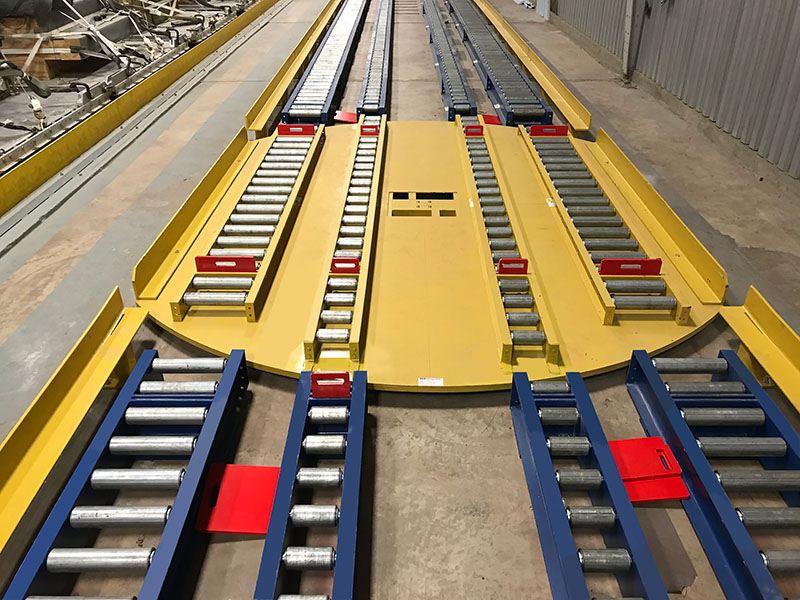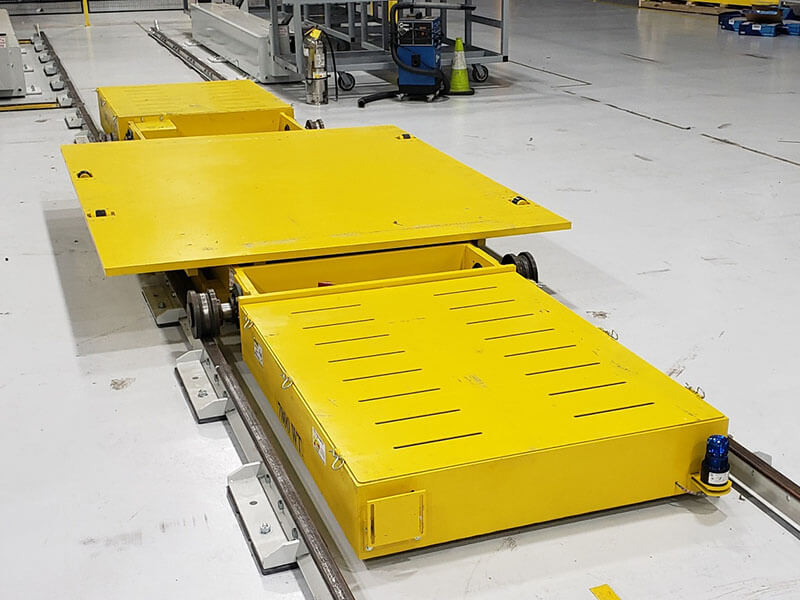Conveyor Transfer Systems by Webb-Stiles
What is a Conveyor Transfer System?
Conveyor transfer systems provide a specialized way to move products between lines, reposition loads, or bridge gaps in a material handling process. These systems ensure precise, reliable movement of goods across workstations, loading zones, or storage areas—improving flow and reducing manual handling.
These systems are especially valuable when space is limited, multiple conveyors intersect, or product orientation needs to change. Unlike standard conveyors that only move product in a straight line, transfer systems reorient and reposition loads with greater precision. Whether moving heavy loads or small containers, conveyor transfer systems support a continuous and controlled workflow.
At Webb-Stiles, we custom-engineer every conveyor transfer system based on load size, direction of travel, movement frequency, and floor space availability. Depending on the application, we may integrate roller conveyors, lifting mechanisms, rotation platforms, or motorized shuttles—ensuring the solution fits into your existing material handling line.
Types of Transfer Systems

Transfer Cars
Transfer cars are mobile platforms that carry materials across multiple bays or conveyor lines. We build each unit to your specifications, including height, track style, and conveyor type. Whether you’re moving a mold, pallet, or container, transfer cars handle loads up to 185,000 lbs with smooth, repeatable motion.
To support system reliability, we integrate safety systems, powered controls, and custom HMIs—ensuring performance in demanding environments from foundries to aerospace.
Best for: Heavy loads, cross-bay transfers, and integrated movement with lifting or rotation functions

Pop-Up Transfers
Pop-up transfers are low-profile mechanisms that lift products off a main conveyor and move them 90 degrees to a perpendicular lane. We typically build these systems into CDLR or belt-driven roller conveyor frames and support zoning, accumulation, or load sorting.
In space-constrained areas, they provide a simple way to divert products without interrupting flow.
Best for: 90-degree load transfers, space-saving re-direction, and zone control in palletizing or packaging lines

Turntables
Turntables rotate pallets, carts, or fixtures in place when product orientation needs to change without shifting the footprint. These systems are available in motorized or manual versions and are often used where conveyors intersect or reorientation is needed between steps.
Each unit includes a structural steel frame, hub/collar pivot, and heavy-duty support casters. Depending on your process, we may also incorporate mounted roller conveyors, pallet stops, or automatic rotation locks as part of the design.
Best for: Reorienting products in tight spaces or between process steps

Shuttle Systems
Shuttle systems use a motorized cart or platform to move loads laterally along a track. This design allows product to reach multiple staging or processing lanes, even when they’re positioned outside the primary conveyor flow.
Shuttle systems are often applied when multiple lines feed a shared zone—or when a single line needs to distribute product across multiple destinations.
Best for: Transferring between parallel lanes or distributing loads across multiple conveyor zones
Applications & Uses
Many facilities use conveyor transfer systems to change direction, shift lanes, or move loads between distinct zones without manual handling. These systems are frequently applied in:
In-Line Process Transitions
-
Changing product orientation between operations
-
Shifting loads between parallel conveyor lanes
-
Feeding or extracting parts from presses or robotic cells
-
Creating right-angle turns where space is limited
Zone-to-Zone Load Movement
-
Moving containers or fixtures between work cells
-
Bridging conveyor gaps between departments or floors
-
Connecting isolated lines in shared work areas
-
Directing product flow toward staging, packing, or shipping zones
Key Features
Conveyor transfer systems are designed to support turning, shifting, or transitioning loads across conveyor zones. Each system offers:
Built to Move Your Load
-
Supports lift, rotation, 90° transfer, and lateral movement
-
Allows multiple transfer systems within a single layout
-
Handles loads from small parts to large industrial items
-
Available in powered or manual configurations
Designed to Fit Your Floorplan
-
Matches your spacing, elevation, and directional flow
-
Integrates across conveyor systems without layout limitations
-
Includes zone controls, stop/start logic, and operator interfaces
-
Safety features like guarding, locks, and sensors included as needed
How Transfer Systems are Engineered
We design each conveyor transfer system around how your product needs to move—and where. At Webb-Stiles, we evaluate a combination of load, motion, layout, and control factors to recommend the right solution for your process.
Load Requirements
We begin by reviewing the size, weight, and handling needs of your product. Some applications involve delicate parts; others require oversized or high-capacity fixtures that call for reinforced structures and drive systems. Because of this, these requirements guide every part of the design—from the frame and rollers to the type of motion used.
Movement Type
We evaluate how the product needs to move within your layout. Does it need to turn, shift lanes, or move between zones? These questions help us determine which motion style—rotation, 90° transfer, lateral travel, or a combination—will keep your process flowing. Instead of a one-size-fits-all approach, each system is configured to match your operation.
Entry & Exit Points
We also evaluate how the load will enter and exit the transfer zone—whether that’s between two conveyors, across a gap, or into overhead or floor-mounted equipment. In addition, elevation, orientation, and transfer timing all play a role in how we design the system and how well it integrates with surrounding equipment.
Control Strategy
Whether the system operates manually or through automation, our in-house controls team configures it to match your process. We consider how often the system moves, what triggers it, and how it communicates with other equipment. Our team may choose to include sensors, timers, or custom HMI screens depending on your environment.
Safety & Access
We review each system for safety and accessibility. This includes guarding, sensors, locks, and clear access points as required by your internal safety protocols and plant layout. For this reason, our goal is to deliver a system that operates efficiently and stays safe to use and maintain.
Available Space
Finally, we assess your available footprint, including obstructions, aisleways, and clearance. Some layouts require compact reorientation systems, while others benefit more from full-length transfer cars. Whatever the case, we build each system to work with your space—not against it.
Downloads & Literature
Webb-Stiles engineers transfer systems around specific layout challenges, which means there’s no single spec sheet that fits every design. While most conveyor transfer systems are custom-built, we’ve included downloads below that give a closer look at two commonly used configurations:
For all other applications—especially pop-up transfers or shuttle systems—our team will design a solution based on your product, process, and layout.
Ready to talk through your transfer system?
Contact our team to talk through your space, product flow, and how we can help bridge the gaps in your process.
